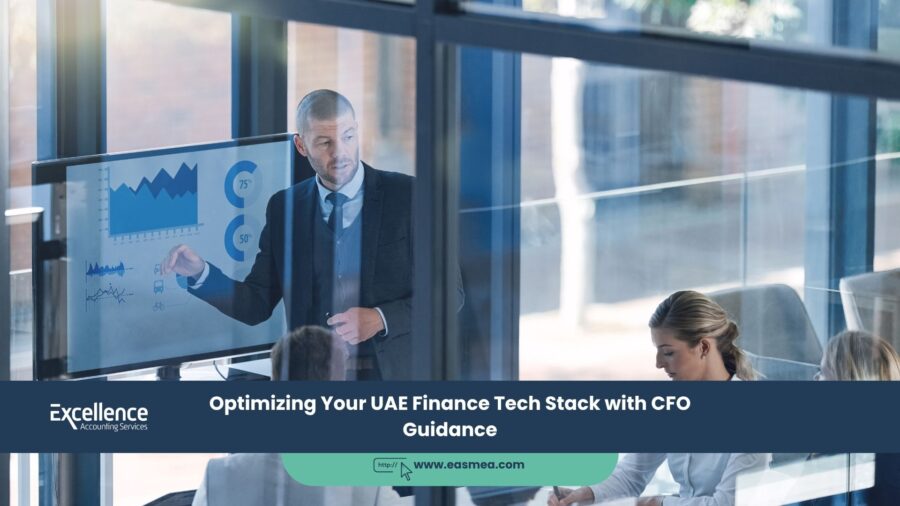From Silos to Synergy: A CFO’s Guide to Optimizing Your UAE Finance Tech Stack
In the UAE’s relentlessly advancing digital economy, the tools that power your finance function are no longer just a matter of convenience—they are a critical determinant of your competitive advantage. An outdated, fragmented collection of spreadsheets and basic software is a liability, creating data silos, manual inefficiencies, and a chronic lack of strategic insight. To thrive, businesses must evolve their financial infrastructure into a seamlessly integrated, data-driven ecosystem. This is the essence of building a modern UAE finance tech stack.
- From Silos to Synergy: A CFO's Guide to Optimizing Your UAE Finance Tech Stack
- The Evolution of the UAE Finance Tech Stack: A Three-Stage Journey
- The CFO's Role: The Architect of Your UAE Finance Tech Stack
- What Excellence Accounting Services (EAS) Can Offer: Your Partner in Building a Future-Ready UAE Finance Tech Stack
- Frequently Asked Questions (FAQs)
- Ready to Build a Tech Stack That Drives Growth?
However, acquiring technology is easy; architecting a cohesive and value-generating stack is not. It requires a strategic vision that goes beyond features and pricing. This is where CFO-level guidance becomes indispensable. The journey to an optimized UAE finance tech stack is not about buying more software; it’s about making intelligent, strategic investments in technology that align with your business goals, scale with your growth, and transform your finance function from a historical record-keeper into a forward-looking strategic partner.
This in-depth guide provides a CFO’s perspective on designing, implementing, and optimizing your UAE finance tech stack. We will walk through the stages of technological maturity, from foundational tools to sophisticated enterprise platforms, and highlight the pivotal role of strategic financial leadership in maximizing your technology ROI.
Key Takeaways
- A Tech Stack is More Than Software: A modern UAE finance tech stack is an integrated ecosystem of tools designed for efficiency, compliance, and strategic insight.
- Evolution is Key: Companies should progress from a foundational stack (basic accounting) to an integrated stack (payroll, expenses) and ultimately a strategic stack (ERP, BI tools).
- CFO Guidance is Crucial: Strategic leadership is essential for selecting the right tools, managing integration, ensuring data integrity, and aligning the tech stack with long-term business objectives.
- Integration Unlocks Value: The true power of a UAE finance tech stack lies in its ability to create a single source of truth, eliminating data silos and enabling real-time analysis.
- ROI is Measured in Strategy: The ultimate return on investment from your tech stack is not just saved time, but the ability to make faster, smarter, data-driven decisions that fuel growth.
The Evolution of the UAE Finance Tech Stack: A Three-Stage Journey
Building a powerful financial technology infrastructure is a marathon, not a sprint. It typically evolves through three distinct stages of maturity, each reflecting the growing complexity and strategic needs of the business.
Stage 1: The Foundational Stack – Getting the Basics Right
For most startups and small businesses, the journey begins here. The primary goal is compliance and control—ensuring every transaction is recorded accurately for VAT, Corporate Tax, and basic financial reporting. The cornerstone of this stage is cloud accounting software.
- Core Technology: Cloud Accounting Platforms like Zoho Books, Xero, or QuickBooks.
- Key Functions: Invoicing, bank reconciliation, VAT reporting, basic P&L and Balance Sheet generation.
- The Challenge: While essential, this foundational stack often operates in a silo. Expense reports are managed on spreadsheets, payroll is calculated manually, and strategic analysis is nearly impossible. It answers “What happened?” but offers little insight into “Why?” or “What’s next?”. A poorly implemented system here can create problems that require a professional accounting review to fix later.
This stage is a necessary starting point, but it is not a destination. Relying on a foundational UAE finance tech stack for too long will stifle growth as manual processes consume valuable time and a lack of data visibility hinders decision-making.
Stage 2: The Integrated Stack – Connecting the Dots
As a business grows, the pain points of the foundational stack become acute. The finance team spends more time on manual data entry and reconciliation between disconnected systems than on analysis. The integrated stack aims to solve this by connecting key financial processes.
- Core Technologies: Cloud accounting platform + integrated applications.
- Added Components:
- Expense Management Tools (e.g., Dext, Wally): Automate receipt capture and employee expense claims, syncing directly with the accounting software.
- Payroll Software: Manages WPS compliance, salary calculations, and leave, integrating with the general ledger. Our payroll services often involve implementing such tools.
- Accounts Payable/Receivable Automation: Tools that streamline invoice processing and automate payment reminders.
- The Benefit: This stage dramatically reduces manual work, improves data accuracy, and provides a more real-time view of the company’s financial position. It begins to build a more cohesive UAE finance tech stack.
Stage 3: The Strategic Stack – Architecting for Insight and Growth
This is the domain of the modern, data-driven enterprise. The goal is no longer just efficiency but strategic foresight. A strategic UAE finance tech stack is a fully integrated ecosystem designed to provide a single source of truth and power sophisticated analysis. This is where CFO leadership is absolutely essential.
- Core Technology: Enterprise Resource Planning (ERP) system (e.g., Oracle NetSuite, SAP Business One, Microsoft Dynamics 365) or a highly integrated “best-of-breed” suite.
- Key Components:
- ERP System: A unified platform that integrates finance, HR, supply chain, and CRM into a single database.
- Business Intelligence (BI) & Analytics Platforms (e.g., Power BI, Tableau): Connect to various data sources to create interactive dashboards, visualize trends, and perform deep-dive analysis.
- Corporate Performance Management (CPM) / FP&A Tools: Advanced software for complex budgeting, forecasting, scenario modeling, and long-range planning.
- Treasury Management Systems (TMS): For larger organizations to manage cash flow, liquidity, and currency risk.
- The Outcome: The finance team is freed from data wrangling and elevated to a strategic role. The business can answer complex questions in real-time, forecast with greater accuracy, and make decisions with confidence. This is the ultimate goal of optimizing your UAE finance tech stack.
The CFO’s Role: The Architect of Your UAE Finance Tech Stack
Technology alone does not create value. The most powerful software is useless without a strategic vision for its use. The role of a CFO or an expert outsourced CFO is to be the architect, not just the user, of the UAE finance tech stack.
How CFO Guidance Maximizes Tech ROI:
- Strategic Selection: A CFO looks beyond features to assess how a technology fits into the long-term business strategy. They ask critical questions: Will this scale with our five-year growth plan? Does it provide the data we need to track our most important KPIs? Does it integrate with our existing systems? This prevents costly mistakes and “shelfware”—software that is bought but never fully utilized.
- Overseeing Implementation and Integration: Implementing new financial software is a complex change management project. A CFO provides the leadership to ensure a smooth transition, from data migration to staff training. A proper accounting system implementation is a strategic project, not an IT task.
- Championing Data Integrity: A CFO understands that the output of any system (like a BI dashboard) is only as good as the input data. They establish the processes and controls necessary to ensure data is accurate, consistent, and reliable across the entire UAE finance tech stack, often verified through an internal audit.
- Translating Data into Strategy: The ultimate role of the CFO is to use the technology to tell a story. They take the data from the BI tools and the forecasts from the FP&A software and translate them into actionable strategic insights for the CEO and the board. They use the UAE finance tech stack to answer the most important questions and guide the company’s future.
What Excellence Accounting Services (EAS) Can Offer: Your Partner in Building a Future-Ready UAE Finance Tech Stack
At Excellence Accounting Services, we combine deep financial expertise with technological know-how to help you build a UAE finance tech stack that drives results. Our approach is strategic and holistic:
- Technology Assessment and Roadmap: We start with a thorough business consultancy approach to understand your current processes and future goals, then develop a clear, phased roadmap for your tech stack evolution.
- System Selection and Implementation: Leveraging our expertise, we help you choose the right software for your needs and budget. Our Accounting System Implementation service ensures a seamless and successful rollout.
- Integration and Automation: We help you connect your systems to eliminate manual work and create a single source of truth, from automating your accounts payable to streamlining your financial reporting.
- Strategic CFO Guidance: Our Outsourced CFO Services provide the strategic oversight needed to ensure your UAE finance tech stack delivers a true return on investment, transforming data into decisions that fuel growth.
Frequently Asked Questions (FAQs)
For a very early-stage business, Zoho Books or Xero is often sufficient. However, you should consider expanding your UAE finance tech stack when you start experiencing specific pain points: your team is spending hours on manual data entry between systems, you can’t get a clear, real-time view of your cash flow, or your expense reporting process is slow and error-prone. The next logical step is often integrating dedicated tools for expense management or payroll automation.
An “all-in-one ERP” (like NetSuite or SAP Business One) aims to provide a single software platform that handles almost all business functions (finance, CRM, HR, etc.). A “best-of-breed” approach involves selecting the very best application for each specific function (e.g., Salesforce for CRM, Xero for accounting, a specialized inventory tool) and integrating them. The ERP approach offers seamless integration but may lack depth in specific areas. The best-of-breed approach offers deep functionality but requires more effort to integrate. A CFO can help determine the right strategy for your specific business needs.
There is no single answer, as it depends on your size, complexity, and industry. A common approach is to budget a percentage of revenue or operating expenses. However, a more strategic method, guided by a CFO, is to focus on ROI. Instead of asking “What does it cost?”, ask “What value will it create?”. This could be measured in hours saved from automation, improved decision-making from better data, or reduced risk from stronger compliance. A feasibility study can help quantify this potential ROI before making a large investment.
Change management is critical. CFO leadership is key here. The process should start with clearly communicating the “why” behind the change—how the new technology will make employees’ jobs easier and more valuable, not just add another task. Involve key team members in the selection process to create buy-in. Provide thorough training and ongoing support. Celebrate early wins and showcase how the new UAE finance tech stack is helping the business succeed.
A data warehouse is a central repository of information that can be analyzed to make more informed decisions. Data is pulled from various sources (like your accounting system, CRM, and operational software), cleaned, and structured for analysis. For most SMEs, a full data warehouse is overkill. However, the principle is important. Modern BI tools like Power BI can connect directly to multiple data sources, acting as a “virtual” data warehouse and allowing you to analyze data from across your entire UAE finance tech stack without the complexity of building a separate system.
A well-organized UAE finance tech stack makes an audit significantly smoother. Cloud accounting systems provide a clear audit trail of every transaction. Integrated systems ensure consistency across records. An external auditor can often be given read-only access to the system, reducing the need for manual data requests. This transparency and organization not only speeds up the audit process but also demonstrates strong internal controls, which reflects positively on the business.
Yes. The key is to be strategic and phased. Start with a solid cloud accounting foundation. Then, identify your single biggest pain point (e.g., expense reporting) and find a cost-effective, integrable tool to solve it. Many modern SaaS applications offer tiered pricing that can grow with you. The mistake is trying to buy a complex ERP system too early. A fractional CFO can be invaluable in creating a lean, high-ROI UAE finance tech stack roadmap that respects your budget.
The biggest mistake is choosing software based on features without first defining the business processes and strategic goals the software needs to support. This leads to buying overly complex or poorly fitting tools. A CFO-led approach reverses this: first, map out your ideal financial processes, then identify your key strategic questions, and only then go to the market to find the technology that fits your pre-defined requirements.
UAE Corporate Tax requires meticulous record-keeping and the ability to produce detailed financial statements and supporting documents. Your UAE finance tech stack must be able to track revenue and expenses accurately, manage fixed asset depreciation schedules, and differentiate between capital and operational expenditures. An integrated system ensures that the data used for your tax filing, managed by your corporate tax consultants, is consistent with your internal management reports, reducing compliance risk.
A “single source of truth” (SSoT) means that everyone in the organization makes decisions based on the same, unified data. It’s the ultimate goal of an integrated UAE finance tech stack. When your sales team uses a CRM and your finance team uses an accounting system that don’t talk to each other, you have two different versions of revenue data—a classic example of multiple sources of truth. An SSoT eliminates these discrepancies, ensuring that strategic conversations are based on accurate, consistent data, not on arguing about whose numbers are correct.
Conclusion: Your Technology is Your Strategy
In the modern UAE economy, your financial technology is no longer a back-office utility. It is a core component of your corporate strategy. A well-architected UAE finance tech stack, guided by expert CFO leadership, can provide the efficiency, control, and—most importantly—the insight needed to outmaneuver the competition and achieve sustainable growth.
The journey from a siloed, foundational stack to a synergistic, strategic ecosystem is a transformative one. It elevates your finance function from a reactive cost center to a proactive value creator, ensuring that every major business decision is powered by timely, accurate, and actionable data.
Ready to Build a Tech Stack That Drives Growth?
Let Excellence Accounting Services help you design and implement a UAE finance tech stack that aligns with your vision. Our blend of strategic CFO guidance and technological expertise will transform your financial operations into a competitive advantage.




